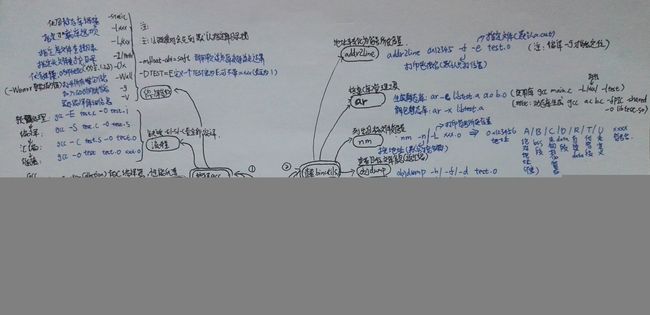简图记录-交叉编译链 使用基础总结
目录
一、概念
二、编译器GCC
1、基本编译命令 与 执行
2、编译流程分解-预处理/编译/汇编/链接
3、编译代码优化 与 常用编译参数
三、查看工具binutils
1、地址转化为符号所在位置 addr2line (编译需要带-g)
2、档案(库)管理工具 ar
3、列出目标文件符号表 nm
4、查看目标文件信息(反汇编)objdump
5、显示可执行文件信息 readelf
6、减少目标文件(瘦身) strip
7、查看文件各段大小 size
四、C库 glibc
一、概念
交叉编译链:在一个平台(如Windows PC)生成另一个平台(如基于ARM芯片的嵌入式linux环境)可执行代码的工具链,主要由编译工具如gcc,查看工具集binutils(包含地址定位addr2line、支持反汇编objdump,文件瘦身strip等),库glibc组成。
学习目标人群:如果你要做嵌入式开发相关工作, 交叉工具编译链是你必须掌握的工具。
二、编译器GCC
GCC:GNU Compiler Collection,GNU编译器套件,是由GNU开发的编程语言译器。
学习gcc,必须了解他的编译指令(预处理 编译 汇编 链接),和常见编译参数使用(加调试信息 头文件路径添加 库路径添加 指定库等)。实际工作中往往是配合Makefile一起使用,Makefile中一些相关的隐含参数也需要了解。
1、基本编译命令 与 执行
以下面举例:
// hello.c 源文件
#include
void test_func(char *str) {
printf("hello world %s\n", str);
return;
}
int main(void) {
test_func("good boy!");
return 0;
}
直接编译命令gcc hello.c -o hello;(将hello.c编译为可执行文件hello,-o xxx 为指定可执行文件名称,缺省则默认为a.out)
goodboy@ubuntu:~/gcc_study$ gcc hello.c -o hello
goodboy@ubuntu:~/gcc_study$ ./hello
hello world good boy!
2、编译流程分解-预处理/编译/汇编/链接
实际编译过程: 经历了 以下四个主要步骤(如果缺省-E/-S/-C编译器会全部编译)。
(1)预处理-E:处理宏定义和include,去除注释,不会对语法进行检查
(2)编译-S:检查语法,生成汇编代码
(3)汇编-c:生成ELF格式的目标代码
(4)链接-O :生成可执行代码。链接分为两种,一种是静态链接,另外一种是动态链接。使用静态链接的好处是,依赖的动态链接库较少,对动态链接库的版本不会很敏感,具有较好的兼容性;缺点是生成的程序比较大。使用动态链接的好处是,生成的程序比较小,占用较少的内存.
编译过程 文件扩展名规范:预处理文件.i 汇编文件.s 目标文件.o
goodboy@ubuntu:~/gcc_study$ gcc -E hello.c -o hello.i #预处理
goodboy@ubuntu:~/gcc_study$ gcc -S hello.i -o hello.s #编译
goodboy@ubuntu:~/gcc_study$ gcc -c hello.s -o hello.o #汇编
goodboy@ubuntu:~/gcc_study$ gcc hello.o -o hello #链接
goodboy@ubuntu:~/gcc_study$ ls -al
total 52
drwxrwxr-x 2 goodboy goodboy 4096 Jun 13 10:12 .
drwxr-xr-x 7 goodboy goodboy 4096 Jun 13 09:56 ..
-rwxrwxr-x 1 goodboy goodboy 8555 Jun 13 10:12 hello
-rw-rw-r-- 1 goodboy goodboy 157 Jun 13 09:56 hello.c
-rw-rw-r-- 1 goodboy goodboy 17239 Jun 13 10:11 hello.i
-rw-rw-r-- 1 goodboy goodboy 1680 Jun 13 10:12 hello.o
-rw-rw-r-- 1 goodboy goodboy 894 Jun 13 10:11 hello.s
3、编译代码优化 与 常用编译参数
代码优化 :实际编译器在编译过程,一个重要的工作就是做代码优化。简单来说就是 代码进行等价变换,使得变换后的代码运行结果相同,但是 运行速度加快或者占用空间减少。代码优化举例:如中间代码优化技术,对局部优化(删除公共表达式、合并已知量,临时变量改名,代数变换等)、循环优化(循环层次外提、变换循环控制条件,循环展开与合并等)。
警告相关编译参数:-w 禁止全部警告; -Werror把警告报告为错误; -Wcomment 注释嵌套警告;-Wformat 检查printf\scanf等格式化io函数 参数类型与类型说明是否一致;-Wreturn-type检查返回值类型是否一致;-Wuninitialized 自动变量未初始化就使用警告;-Wsign-compare 有无符号比较警告;
调试选项:-g 生成调试信息(用于gdb访问);
优化选项:-O1优化(编译过程更耗时、占内存,试图减少最终size合运行时间);-O2 进一步优化(常用);-O3 打开全部优化;-O0不进行优化;-Os 只优化大小;
预编译选项:-D宏名称[=宏值] 编译过程加入宏,如果缺省赋值默认为“1”;-U宏名 取消宏定义;
查找目录与查找库选项:-l
Linux平台 附加编译选项:-fPIC 地址无关化(重定位 .o、动态库);-fPIE -pie 随机化;GOT表保护 -Wl,-z,relro(链接命令,用户态程序使用);-fstack-check 编译时检查申请栈空间是否超过4K(大小可调),运行时超过会segmentation fault;
三、查看工具binutils
对于binutils,要掌握场景工具用法帮助问题的分析定位,如addr2line,ar,nm,objdump,readelf,strip,size。
1、地址转化为符号所在位置 addr2line (编译需要带-g)
用法举例:addr2line 0x12345 -f -e test.o;#-f参数会打印函数名称(默认只打印位置) -e 为指定调试文件(缺省为a.out)
void test_func(void) {
int b = 0;
int a = 10 / b; # 故意搞一个除零错误
printf("a = %d\n", a);
return;
}
int main(void) {
test_func();
return 0;
}
我们搞一个除零错误,然后通过dmesg看coredump找到对应报错信息,找到崩溃时ip地址,再用工具addr2line定位 到 是hello.c文件第四行,函数 test_func中,行号也能对应上出错位置。
goodboy@ubuntu:~/gcc_study$ gcc hello.c -g -o hello
goodboy@ubuntu:~/gcc_study$ ./hello
Floating point exception (core dumped)
goodboy@ubuntu:~/gcc_study$ dmesg #demsg查看coredump信息(省略一部分无关信息)
[219664.542213] traps: hello[49208] trap divide error ip:400542 sp:7ffedb0c0ba0 error:0 in hello[400000+1000]
goodboy@ubuntu:~/gcc_study$ addr2line 0x400542 -f -e hello
test_func
/home/goodboy/gcc_study/hello.c:4
goodboy@ubuntu:~/gcc_study$ cat -n hello.c
1 #include
2 void test_func(void) {
3 int b = 0;
4 int a = 10 / b;
5 printf("a = %d\n", a);
2、档案(库)管理工具 ar
生成静态库:ar -c libtest.a a.o b.o; 把a.o和b.o生成libtest.a静态库---使用方式 gcc main.c -L<库路径> -ltest
解包静态库:ar -x libtest.a
生成动态库: gcc a.c b.c -fPIC -shared -o libtest.so;
3、列出目标文件符号表 nm
用法举例:nm -n(按地址)/-L(按符号所在位置)/(缺省按名称) xxx.o
第一列为地址,第二列 为类型(A绝对地址 B bss段 C 未初始化 D data段 R 只读data T 代码段 U未定义),第三列为符号名称
goodboy@ubuntu:~/gcc_study$ nm hello
0000000000601040 B __bss_start
0000000000601040 b completed.6982
0000000000601030 D __data_start
0000000000601030 W data_start
0000000000400470 t deregister_tm_clones
00000000004004e0 t __do_global_dtors_aux
0000000000600e18 t __do_global_dtors_aux_fini_array_entry
0000000000601038 D __dso_handle
0000000000600e28 d _DYNAMIC
0000000000601040 D _edata
0000000000601048 B _end
00000000004005e4 T _fini
0000000000400500 t frame_dummy
0000000000600e10 t __frame_dummy_init_array_entry
0000000000400748 r __FRAME_END__
0000000000601000 d _GLOBAL_OFFSET_TABLE_
w __gmon_start__
00000000004003e0 T _init
0000000000600e18 t __init_array_end
0000000000600e10 t __init_array_start
00000000004005f0 R _IO_stdin_used
w _ITM_deregisterTMCloneTable
w _ITM_registerTMCloneTable
0000000000600e20 d __JCR_END__
0000000000600e20 d __JCR_LIST__
w _Jv_RegisterClasses
00000000004005e0 T __libc_csu_fini
0000000000400570 T __libc_csu_init
U __libc_start_main@@GLIBC_2.2.5
000000000040055f T main
U printf@@GLIBC_2.2.5
00000000004004a0 t register_tm_clones
0000000000400440 T _start
000000000040052d T test_func
0000000000601040 D __TMC_END__
4、查看目标文件信息(反汇编)objdump
用法举例:objdump -h(段信息)/-f(文件头)/-d(反汇编 带-S可同时打印C代码) test.o
goodboy@ubuntu:~/gcc_study$ objdump -d -S hello.o # 省略了部分内容
hello.o: file format elf64-x86-64
Disassembly of section .init:
00000000004003e0 <_init>:
4003e0: 48 83 ec 08 sub $0x8,%rsp
4003e4: 48 8b 05 0d 0c 20 00 mov 0x200c0d(%rip),%rax # 600ff8 <_DYNAMIC+0x1d0>
4003eb: 48 85 c0 test %rax,%rax
4003ee: 74 05 je 4003f5 <_init+0x15>
4003f0: e8 3b 00 00 00 callq 400430 <__gmon_start__@plt>
4003f5: 48 83 c4 08 add $0x8,%rsp
4003f9: c3 retq
0000000000400410 :
400410: ff 25 02 0c 20 00 jmpq *0x200c02(%rip) # 601018 <_GLOBAL_OFFSET_TABLE_+0x18>
400416: 68 00 00 00 00 pushq $0x0
40041b: e9 e0 ff ff ff jmpq 400400 <_init+0x20>
000000000040052d :
40052d: 55 push %rbp
40052e: 48 89 e5 mov %rsp,%rbp
400531: 48 83 ec 10 sub $0x10,%rsp
400535: c7 45 f8 00 00 00 00 movl $0x0,-0x8(%rbp)
40053c: b8 0a 00 00 00 mov $0xa,%eax
400541: 99 cltd
400542: f7 7d f8 idivl -0x8(%rbp)
400545: 89 45 fc mov %eax,-0x4(%rbp)
400548: 8b 45 fc mov -0x4(%rbp),%eax
40054b: 89 c6 mov %eax,%esi
40054d: bf f4 05 40 00 mov $0x4005f4,%edi
400552: b8 00 00 00 00 mov $0x0,%eax
400557: e8 b4 fe ff ff callq 400410
40055c: 90 nop
40055d: c9 leaveq
40055e: c3 retq
000000000040055f :
40055f: 55 push %rbp
400560: 48 89 e5 mov %rsp,%rbp
400563: e8 c5 ff ff ff callq 40052d
400568: b8 00 00 00 00 mov $0x0,%eax
40056d: 5d pop %rbp
40056e: c3 retq
40056f: 90 nop
5、显示可执行文件信息 readelf
用方举例:readelf -h(读取头信息)/-S(读取段信息) test.o
goodboy@ubuntu:~/gcc_study$ readelf -h hello.o
ELF Header:
Magic: 7f 45 4c 46 02 01 01 00 00 00 00 00 00 00 00 00
Class: ELF64
Data: 2's complement, little endian
Version: 1 (current)
OS/ABI: UNIX - System V
ABI Version: 0
Type: EXEC (Executable file)
Machine: Advanced Micro Devices X86-64
Version: 0x1
Entry point address: 0x400440
Start of program headers: 64 (bytes into file)
Start of section headers: 4472 (bytes into file)
Flags: 0x0
Size of this header: 64 (bytes)
Size of program headers: 56 (bytes)
Number of program headers: 9
Size of section headers: 64 (bytes)
Number of section headers: 30
Section header string table index: 27
6、减少目标文件(瘦身) strip
用法:strip -H删除文件头/-l删除行号/-r删除调试信息/-t删除符号表 test.o
7、查看文件各段大小 size
用法:size test.o
goodboy@ubuntu:~/gcc_study$ size hello.o
text data bss dec hex filename
1284 560 8 1852 73c hello.o
四、C库 glibc
对于C库,知道能支持做什么,如何使用,后续可以学习如何编译,升级。
